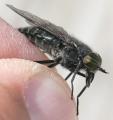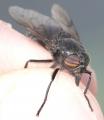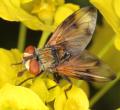Diptera.info :: Miscellaneous :: General queries
Who is here? 1 guest(s)
|
Storing flies in alcohol
|
|
| Carnota |
Posted on 12-10-2007 12:38
|
|
Member Location: Galicia (Spain) Posts: 170 Joined: 29.05.06 |
I print the labels with a cheap laser printer in acid free paper and put them inside the Eppendorfs. Country, province, municipality, habitat, UTM coordinate, altitude, day and leg figure in the label.
Carnota attached the following image: 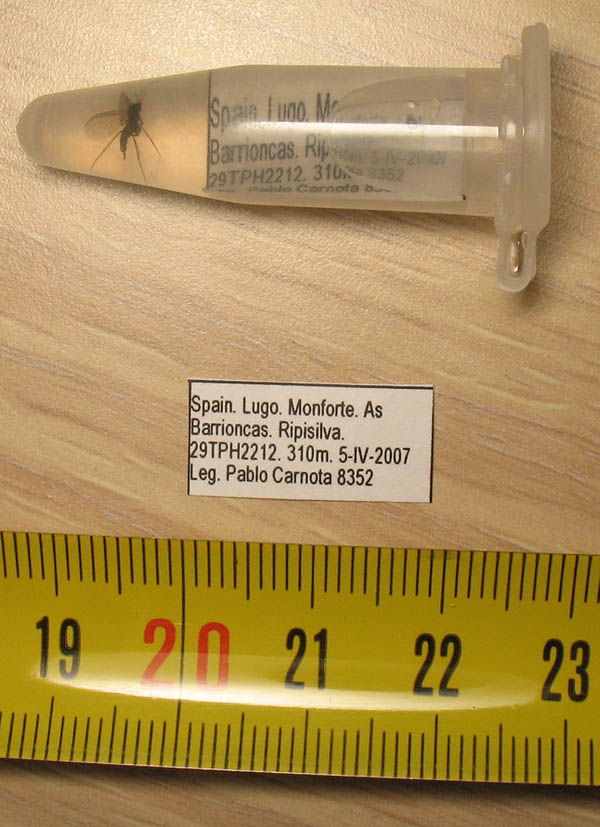 [96.07Kb] |
|
|
|
| Carnota |
Posted on 12-10-2007 12:42
|
|
Member Location: Galicia (Spain) Posts: 170 Joined: 29.05.06 |
I do use also glass vials of several sizes. I am not an expert, may be someone can give you (and me) better ideas. Carnota attached the following image: 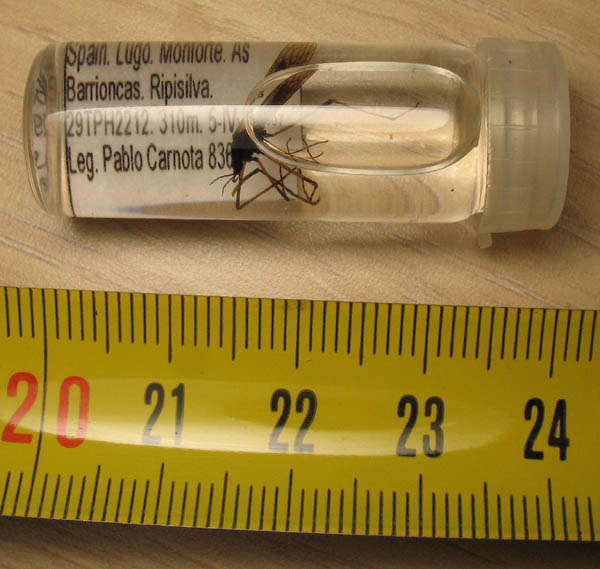 [68.62Kb] |
|
|
|
| crex |
Posted on 12-10-2007 13:53
|
|
Member Location: Sweden Posts: 1996 Joined: 22.05.06 |
Thank you Carnota for the illustrations. I like the vials with flat bottom best. I have been browsing online Lab Equipment catalogues. The size of the tubes (in ml) seems to be pretty standardized. Best if I find a company in Sweden where I can buy it. I found some, but not all sells to private persons. I'm looking for the transparent, flat-bottomed tubes with twist-off caps. |
|
|
|
| Adrian |
Posted on 22-10-2007 12:32
|
|
Member Location: Posts: 69 Joined: 05.01.07 |
I have been using alcohol for about 30 years (for storing Diptera) and offer a few comments. Firstly, change the alcohol a week or two after collecting the specimen as the original fluid will become diluted. After that, its probably OK. I always use screw capped plastic vials (don't like Eppendorf's as the caps can pop off). These vials are sold by various manufacturers in different sizes as cryopreservation tubes and are highly inert and stable. Adding glycerol at 5% will minimize risks if it drys out. Keep specimens in the dark and preferably cool/cold and colour losses are reduced. If you want to subsequently pin the specimen, hold it in ethyl acetate until the ethanol has exchanged and then dry it out on filter paper (you will find that oily flies like therevids loose their fat and become much better than if you pinned them immediately). Normal 'india' ink seems to be stable for at least 30 years with no sign of deterioration but make sure the ink is absolutely dry before you put the label in the tube. I have noticed no deterioation with computer-printed labels over about 10 years and suspect that they are OK too. A problem with wet preserved material is that dusting is hard to see . However it is usually possible with a bit of experience and changing the lighting and background carefully. I find that alcohol preserves morphology (apart from dusting) much better than does dry-mounting but colour can be a problem. Experience with a particular key usually solves this problem but not always, especially as wet material tends to fade. One usuful tip; if your flies have important features that are hidden when the specimen shrivels on drying (eg. legs that close up hiding setae, genitalia that shrink and distort etc). Collect then into Gaults solution or similar (even dilute salt solution will do):- all the legs straighten out and everscible structures expand; you can then wah them with water before putting them in alcohol which will 'fix' the structures in their expanded state:- if you do this you may find yourself performing far fewer genutalia dissections! Lastly; if you are in the business of describing species, please state if its a dry or wet specimen that is being described. e.g its common to find a black thorax with yellow dusting and the thorax could equally be described as black or yellow if described from dry (so many keys fall into this error and even famous dipterists do!). Wet material is more likely to be described as having a black thorax with yellow dusting and hence would be more accurate.......... One question I do have:- what to do with genitalia once they have become separated:- if they are put back with the specimen they might get lost but it would be dreadful practice to put them in another tube from the original specimen. I'd appreciate any thoughts on this hope it helps cheers Adrian |
|
|
|
| Tony Irwin |
Posted on 22-10-2007 14:22
|
|
Member Location: Norwich, England Posts: 7286 Joined: 19.11.04 |
Adrian wrote: One question I do have:- what to do with genitalia once they have become separated:- if they are put back with the specimen they might get lost but it would be dreadful practice to put them in another tube from the original specimen. I'd appreciate any thoughts on this If the specimen is going to be stored long-term in alcohol (and there are arguments for extracting and pinning or slide-mounting all specimens that are to be kept) then you can put disected genitalia in a glass or plastic microvial and store that in the tube with the specimen. Tony ---------- Tony Irwin |
|
|
|
| Smoggycb |
Posted on 22-10-2007 14:31
|
|
Member Location: Rye Harbour, England Posts: 350 Joined: 19.05.07 |
Could anyone suggest a suitable supplier for micro-vials for this type of storage? I have found a couple of companies in America and Australia which supply them, but none closer! |
|
|
|
| ChrisR |
Posted on 22-10-2007 23:42
|
|
Super Administrator Location: Reading, England Posts: 7703 Joined: 12.07.04 |
If you just want small quantities then I think Watkins & Doncaster sell a variety of little stoppered glass bottles: http://www.watdon..._home.html You could also try Henshaws - or any supplier of microscopy equipment perhaps. I will ask around to see if I can get some pointers from my lab contacts.  |
| jorgemotalmeida |
Posted on 23-10-2007 02:11
|
|
Member Location: Viseu - PORTUGAL Posts: 9296 Joined: 05.06.06 |
Chris Raper wrote: If you just want small quantities then I think Watkins & Doncaster sell a variety of little stoppered glass bottles: http://www.watdon..._home.html You could also try Henshaws - or any supplier of microscopy equipment perhaps. I will ask around to see if I can get some pointers from my lab contacts.  Show us some image of those vials.  |
| Adrian |
Posted on 23-10-2007 08:46
|
|
Member Location: Posts: 69 Joined: 05.01.07 |
If one puts a microvial in with the same tube as the specimen it would have to be secured in some way otherwise it would be like putting the specimen in a bead mill:- it would soon be utterly destroyed. So presumably the microvial has to be secured somehow inside the specimen tube, in a way where it will not move, there are no dead spaces into which the specimen can move, and in which both it and the specimen can easily be removed for examination. How is this done? cheers Adrian |
|
|
|
| Tony Irwin |
Posted on 23-10-2007 14:20
|
|
Member Location: Norwich, England Posts: 7286 Joined: 19.11.04 |
Adrian wrote: So presumably the microvial has to be secured somehow inside the specimen tube, in a way where it will not move, there are no dead spaces into which the specimen can move, and in which both it and the specimen can easily be removed for examination. How is this done? It can be held in place with a rolled-up piece of tissue, at the bottom of the tube. To examine it, you remove the fly from the tube, then remove the microvial, then open the microvial and get the genitalia out. (It is tedious - and is one of the reasons why long-term storage of reference material is better as pinned specimens.) Tony ---------- Tony Irwin |
|
|
|
| Adrian |
Posted on 23-10-2007 15:32
|
|
Member Location: Posts: 69 Joined: 05.01.07 |
Thanks Tony I'll give it a try. I presume that best to use optical tissue than some paper based one (tend to break into lots of bits on long storage). I have to take slight (but not pedantic) issue with your view that dry material is always better for long term storage. Sometimes it is, sometimes it isn't. I wouldn't keep a cecidomyiid on a pin but would keep a syrphid that way. Generally I favour alcohol but its a case of 'horses for courses' Dry material is very prone to damage and while I am sure that, like me, you can think of 150 year old types which are still in excellent condition; you can probably also think of many sad damaged specimens which have not stood the test of time. Basically, if you use dry material frequently for a long period, damage is more or less inevitable. Wet material is buffered against vibration damage by the viscosity of the fluid and does seem to survive well if treated sensitively (although I'll only conclude my argument in 100 years or so!). Modern containors mean that there is no reason why a vial needs to have its alcohol topped up for decades (probably 100's of years in reality) and inert plastic technology is such that exposure to air pollution, acid leachates etc is virtually nil. There is no excuse nowardays (except being poor!) for the flat-earth technology of upturning tubes in jars of alcohol etc etc (even though many current texts still groan out the neccessity of this ancient and arcane ritual. However, my main reason for generally favouring wet preservation is that morphology is better maintained. Many dry specimens distort as they dry and I have many times, when examining a type, marvelled at the flight of fancy (or perhaps better:- educated guesswork) that enabled the original author to imagine what the thing actually looks like in life rather than what they had before them! Just one specific example of this:- the empidid genus Monodromia Collin was characterised by having distinctly upturned antennae. They aren't actually, when seen in life or in wet material:- its just that Collin (who was an amazingly competent taxonomist) had a shrivelled up type to deal with and never saw its true morphology. I contend that were Collin have been using wet material he never would have made this bizarre error Incidentally, I often find that if I must dry a specimen from alcohol, it can be better than dry-mounting it directly. One has to be careful that the wings etc remain open on drying. Material critical point dried from alcohol can be supurb (if brittle) but CPD equipment is expensive and not available to most. Just some thoughts. I think we should keep open minds about preservation techniques and use which combination best serves our purpose. Thanks again for the feedback cheers Adrian |
|
|
|
| John Bratton |
Posted on 23-10-2007 16:37
|
|
Member Location: Menai Bridge, North Wales, UK Posts: 654 Joined: 17.10.06 |
So long as there is only one fly in the tube, the genitalia shouldn't get lost. I make a note in the record book and put an extra label in the tube to remind me that the genitalia are loose in the tube. Another option is to mount the genitalia on card so they can be pinned, although they are then separate from the rest of the specimen. There is a substance called Dimethyl Hydantoin Formaldehyde or DMHF that the coleopterists use for mounting beetle genitalia. You buy it as a white crystal and dissolve it 50/50 in water to produce a clear treacle. With a pinhead you put a tiny spot on a piece of card and then place the genitalia in. The genitalia need to be wet so that they don't contain air bubbles and float, but not too wet so that they don't dilute the DMHF. I take them out the alcohol, just touch them on to tissue paper so that 90% of the liquid is sucked off by capillary action, then put the genitalia into the DMHF. You then have about a minute or two to manoeuvre the genitalia with pins into the position you want them, after which the DMHF gets too stiff. It soon sets to give a clear hard protective capsule over the genitalia, with excellent optical properties. If in the future the DMHF gets cracked or scratched or you really need a different view, the DMHF can be redissolved in alcohol and the genitalia extracted. Or if you expose DMHF to fumes of ethyl acetate, it just vanishes into the air leaving the genitalia exposed on the card. The biggest problem with DMHF is how to get some. Apparently it is a component in hair spray. You could buy it by the kilo but that is very expensive when 5 mls would be enough to last most amateurs a lifetime. But it seems to be very difficult to find for sale in any quantity these days, so if any Diptera.info members find a source, please let us know. However, this recent mailing on the British beetles e-mail group may offer an alternative: ?Entomologist (and retired chemist) Juan De Ferrer who lives in Algeciras, Spain, has recently been selling small (c. 20 ml) bottles of "improved PVP" solution to EU countries, except the UK, for about 4 Euros each. PVP is very slightly amber in colour but is otherwise identical to DMHF (The Coleopterist 14: 29-35}.? Unfortunately, no contact details for Juan de Ferrer were given. Perhaps one of our Spanish correspondents knows him? I don?t know what PVP stands for. John Bratton |
|
|
|
| jorgemotalmeida |
Posted on 23-10-2007 17:13
|
|
Member Location: Viseu - PORTUGAL Posts: 9296 Joined: 05.06.06 |
here John Bratton  Juan de Ferrer Andreu. Algeciras , C?DIZ jdeferrer (at) wanadoo.es Cole?pteros, Histeridae 4 euros per each?  Saludos, from Spain.  Cumprimentos, from Portugal.  |
| Tony Irwin |
Posted on 23-10-2007 17:18
|
|
Member Location: Norwich, England Posts: 7286 Joined: 19.11.04 |
John Bratton wrote:Unfortunately, no contact details for Juan de Ferrer were given. Perhaps one of our Spanish correspondents knows him? I don?t know what PVP stands for. polyvinyl pyridine Tony ---------- Tony Irwin |
|
|
|
| Tony Irwin |
Posted on 23-10-2007 17:30
|
|
Member Location: Norwich, England Posts: 7286 Joined: 19.11.04 |
Adrian wrote:I have to take slight (but not pedantic) issue with your view that dry material is always better for long term storage. Sometimes it is, sometimes it isn't. I wouldn't keep a cecidomyiid on a pin but would keep a syrphid that way. I think the main argument against long-term storage in alcohol is that without adequate fixing, and carefully controlled concentrations, the material will eventually disarticulate. I agree completely with what you say about damage to dry specimens (not to mention the dreaded Anthrenus!  ) but I do find that a dry reference collection is much easier to work with - I can line up half a dozen specimens of closely related species and compare them directly - they are never separated from their data or determination labels, so never go back in the wrong place - not so easy to accomplish with specimens out of tubes! I wouldn't pin a cecidomyid, or a sciarid, or a phorid, but I would slide-mount them for examination and long-term storage. But then I need to decide what mountant to use (but that's another thread! ) but I do find that a dry reference collection is much easier to work with - I can line up half a dozen specimens of closely related species and compare them directly - they are never separated from their data or determination labels, so never go back in the wrong place - not so easy to accomplish with specimens out of tubes! I wouldn't pin a cecidomyid, or a sciarid, or a phorid, but I would slide-mount them for examination and long-term storage. But then I need to decide what mountant to use (but that's another thread!  ) )
Tony ---------- Tony Irwin |
|
|
|
| jorgemotalmeida |
Posted on 23-10-2007 17:39
|
|
Member Location: Viseu - PORTUGAL Posts: 9296 Joined: 05.06.06 |
Tony Irwin wrote: Adrian wrote:I have to take slight (but not pedantic) issue with your view that dry material is always better for long term storage. Sometimes it is, sometimes it isn't. I wouldn't keep a cecidomyiid on a pin but would keep a syrphid that way. I think the main argument against long-term storage in alcohol is that without adequate fixing, and carefully controlled concentrations, the material will eventually disarticulate. I agree completely with what you say about damage to dry specimens (not to mention the dreaded Anthrenus!  ) but I do find that a dry reference collection is much easier to work with - I can line up half a dozen specimens of closely related species and compare them directly - they are never separated from their data or determination labels, so never go back in the wrong place - not so easy to accomplish with specimens out of tubes! I wouldn't pin a cecidomyid, or a sciarid, or a phorid, but I would slide-mount them for examination and long-term storage. But then I need to decide what mountant to use (but that's another thread! ) but I do find that a dry reference collection is much easier to work with - I can line up half a dozen specimens of closely related species and compare them directly - they are never separated from their data or determination labels, so never go back in the wrong place - not so easy to accomplish with specimens out of tubes! I wouldn't pin a cecidomyid, or a sciarid, or a phorid, but I would slide-mount them for examination and long-term storage. But then I need to decide what mountant to use (but that's another thread!  ) )As a matter of fact, I think Cecidomyid should never pinned... they are so fragile! I put always these flies in ethanol 70% (i need to get some glicerin as well... I use this thumb's rule: 1 drop of glicerin for small, very small flies; 2 drops for medium flies and 3-4 drops for the big ones in a small vial (1 cm diameter, about 4 cm lenght.) Hopefully this weekend I will show the vials I use. The big problem is that it is not easy to see the specimens through the plastic surface... but the vials have good quality. And we can buy 1000 vials for 45 euros.... I use vegetal paper inside the vial with data (written in pencil, of course) and it works very well! The data are well visible in spite of being a plastic surface...  I put the label outside the vial on the cap (?) and surrounding the plastic surface at least 1/4 of the vial. I put the label outside the vial on the cap (?) and surrounding the plastic surface at least 1/4 of the vial.
Edited by jorgemotalmeida on 23-10-2007 17:44 |
| Adrian |
Posted on 24-10-2007 08:22
|
|
Member Location: Posts: 69 Joined: 05.01.07 |
Thanks John Tony & Jorge Unfortunately, I mostly work with smallish species, invariably 5mm or less and often less than 2mm in length:- the genit are correspondingly small and could easily get lost in the tube. I do often mount up the genit prep for dried material (usually in euparal between 2X6mm coverslips inserted in card with a similar hole in it and then mounted on a pin) but doing this for a wet specimen and thus separating it from its genitalia is not an option. There are of course many problems with any solid mounted approach but a major one for me is that the genit can't be rotated to see its 3-dimensional structure. I think Tony's point about ease of examining dry material is a good one although a bit of practice, a fine brush and suitable watch glasses or similar, the difference diminishes greatly. The potential to separate specimens from their labels is very real however and needs a considered & methodical approach. I really don't think that there is a single and simple solution to what is the 'best' way to preserve Diptera. Each method has merits and demerits depending on objectives, personal preferences, facilities and resources. We just need to be aware of these advantages and limitations and be alive to possible ways to improve things. A (slightly) related topic which perhaps should be a separate thread:- I have recently been experimenting with collecting bulk samples into lactic acid which partially clears and fixes the specimens. Colour is changed of course but the partial clearing seems to not only make the genitalia more examinable, but also enables many other external features to be seen more clearly. Specimens can be transferred to alcohol or slide-mounted subsequently. It might be a technique with potential for groups where morphology is more important than colour perhaps? cheers Adrian |
|
|
|
| crex |
Posted on 05-11-2007 12:21
|
|
Member Location: Sweden Posts: 1996 Joined: 22.05.06 |
Thanks again for all input on this subject. Specially to Adrian. Adrian, what size of microtubes (vials) do you use and do you also (as Paul) keep only one speciemen per vial? About the transparent vials. Is it possible to examine the specimen through the "glass" or do you need to take it out of the vial? jorgemotalmeida wrote:... And we can buy 1000 vials for 45 euros.... Where? |
|
|
|
| Adrian |
Posted on 05-11-2007 14:57
|
|
Member Location: Posts: 69 Joined: 05.01.07 |
I mostly use 1.5ml tubes but larger ones are available (5 and 10 ml I think). I have a large stock of these tubes I got a long time ago. They are only semi-transparent and you have to take the specimen out of the tube to see it well enough to do anything with it although the labels are clearly visible (from time to time I have been sent clearer vials so they are available somewhere but I still think that they arn't clear enough to get a good view of whats inside I usually keep just 1-5 specimens inside each tube but sometimes as many as 50:- it can be a good way to keep bulk material in a collection. cheers Adrian |
|
|
|
| michal tkoc |
Posted on 06-11-2007 18:10
|
|
Member Location: Prague, Czech Republic Posts: 237 Joined: 07.11.06 |
I have big problem with glued-up wings, when I am getting my flies off the 70% ethanol. I want to pin the specimen then, so do you have any tips how to do that? How to dry? When I use some paper (vegetal), the wings are still distorted or glued on body or glued-up with each other. When I give the specimen back into the ethanol, wings are nicely straight. When I give the specimen back into the ethanol, wings are nicely straight.
Curator of Diptera, Entomology Department, National Museum Prague. PhD. Student, Charles University. Prague, Czech Republic. |
| Jump to Forum: |


